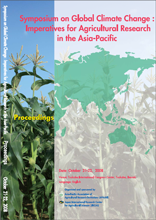Tools and Techniques for Adaptation and Mitigation Research

Agricultural systems are inherently sensitive to variability in weather and climate, whether
naturally-forced or due to human activities. Robust predictions of possible changes in crop
productivity and crop distribution due to climate in the future are vital for our understanding and
management of cropping systems over the coming years to decades.
The Intergovernmental Panel on Climate Change defines adaptation as ‘the adjustment in
natural or human systems in response to actual or expected climate stimuli or their effects, which
moderates harm or exploits beneficial opportunities’ (Parry et al. 2007). Mitigation is the actions taken
to reduce greenhouse gas emissions or enhance their sinks (Verbruggen, 2007). Most crop adaptation
studies in practice study both the impacts and adaptation of climate change. For example, an
assessment of sowing a different crop genotype (as an adaptation option) may be examined in
response to the impacts of artificially imposed changes in climate and atmospheric conditions, such as
elevated CO2 or warmer temperature. Tools and techniques for adaptation and mitigation research on
crops comprise those that involve plant experiments and those that employ simulation modelling.
Different plant experiment techniques range from those that use plant growth chambers to
impose tightly controlled differences in climate to those in near-field conditions that more closely
match some aspects of projected climate changes. The latter include Free-Air CO2 Enrichment rings
(for the study of responses to CO2 and drought), temperature gradient tunnels (CO2 and temperature)
and open-topped chambers (CO2 or ozone). None of these experiment systems entirely simulate all
components of a changed climate, but meta-analyses of many of these studies can provide a broad
consensus of impacts of climate change (for example, Ainsworth et al. 2005) that potentially can
inform adaptation options. Plant experiments to study possible mitigation options from agricultural
systems may include the measurement of methane emissions from paddy rice soils with treatments
such as altered water management, different soil organic matter content or rice cultivars that may
result in lower methane emissions. Also, results from such crop plant experiments are used extensively
to develop, evaluate and parameterise crop simulation models.
Many assessments of adaptation options for agriculture in future climates use simulation models.
Such assessments of the impacts of and adaptation to climate change involve two quite different
models; a climate model and a crop or agricultural system model. Understanding the nature of each
type of model is crucial to interpretation of simulation results for adaptation. In particular, numerical
climate models and crop simulation models are on different spatial and temporal scales. Climate
change projections are made using general circulation models (GCM) run at the global scale.
Adaptation options in agriculture are commonly at a much smaller scale, often at the level of a farm
where many decisions are made. GCM output can be used directly for assessments over large areas,
such as countries and regions (eg Challinor et al., 2004). However, more often downscaling of climate
information is done prior to the crop simulation using either dynamical methods (regional climate
models run with GCM boundary conditions) or statistical techniques (for example, weather
generators). There are even techniques that combine the use of some GCM output directly with
statistical techniques, for example to reconstruct patterns of rainfall (for example, Hansen et al 2006).
There are important sources of uncertainty within climate ? crop projections that need to be
recognised in order to quantify the boundaries of confidence of assessments of adaptation options.
Uncertainty arises from internal (natural) variability within climate models, greenhouse gas emission
scenarios, as well as from the representation of processes in climate models and crop simulation
models. Recent studies have started to account for these sources of uncertainty in an explicit manner
(eg Hawkins and Sutton, 2008; Challinor et al., 2008). Mitigation research in agriculture using simulations requires a representation of land-surface
processes that contribute to greenhouse gas emissions and their interaction with agricultural practices.
Land surface processes are included in earth systems models, or the land surface schemes of GCMs;
for example, the Joint UK Land Environment Simulator (http://www.jchmr.org/jules/). However, there
is currently only a basic representation of agriculture and cropland in these models. Nevertheless,
these models have the potential to capture the feedbacks between changes to agricultural practices and
land use and greenhouse emissions to the atmosphere in a consistent manner. Hence, this is an active
research field.
In conclusions, a range of research tools are available to study adaptation and mitigation of
agriculture to climate variability and change, from well-established plant experiment techniques, to the
mature discipline of crop simulation modelling and the potential of the next generation of earth
systems models.
| 刊行年月日 | |
|---|---|
| 作成者 | Tim Wheeler |
| 著者キーワード |
Climate change earth system modelling plant experiments crop simulation models |
| 公開者 | Japan International Research Center for Agricultural Sciences |
| オンライン掲載日 | |
| 号 | 2008 |
| 開始ページ | 56 |
| 終了ページ | 62 |
| 権利 | Japan International Research Center for Agricultural Sciences |
| 言語 | eng |
